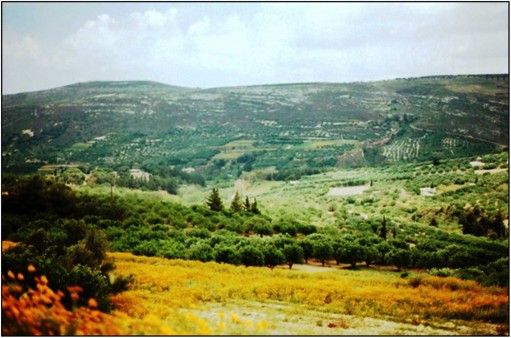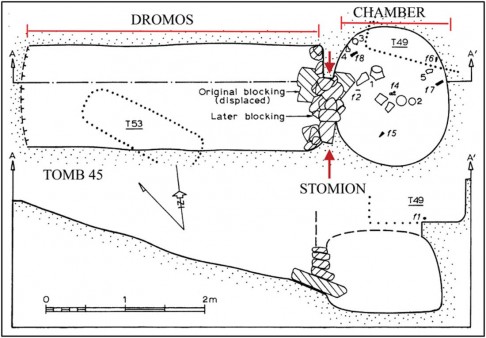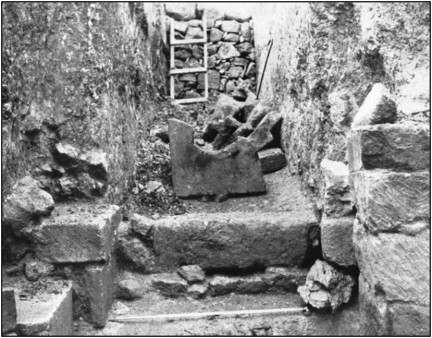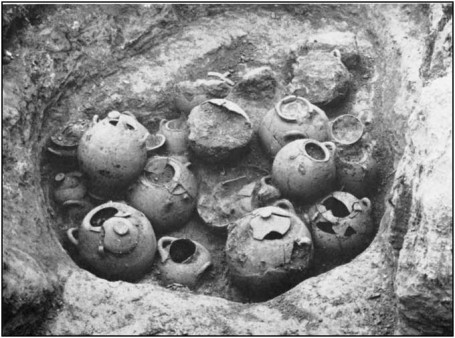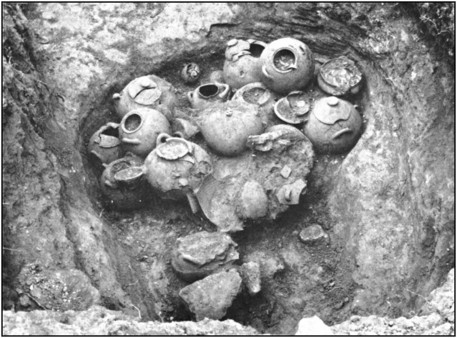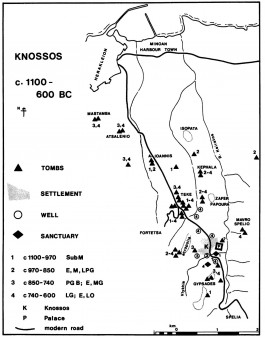In this article I wish to make a presentation and synthesis of all the fully published Early Iron Age tombs from the cemeteries at Knossos. The reason for this article is that after 112 years of continuous investigations in the area and an absolutely disastrous World War II a lot of evidence has been lost or displaced and even place names have been changed [note 1]. An example is the old suburb of Teke or Tekke that is part of the city of Heraklion with the name Ambelokipi [note 2]. At the same time this article is an account of the excavations in the area. However its most valuable contribution is that it may serve as a useful tool for people who wish to proceed to contextual investigations because one of the most important parameters of contextual archaeology is the use of all the evidence from a specific archaeological context [note 3]. Another aspect of this article is related to the use of Bronze Age tombs during the Early Iron Age.
Since the beginning of Evans’ excavations and despite the worldwide impact of his discovery, Bronze Age Crete and its Minoans were not the sole focus of the investigations in Knossos. At that time, the director of the BSA, David Hogarth, conducted an investigation into burial structures. This was in as early as 1900, the very same period when Evans was revealing the first fragmented frescoes from the Bronze Age Palace. Hogarth’s primary aim was to discover the tombs associated with the Minoan hierarchy (Coldstream 2002, 202). In other words, he was after the tombs of the Minoan Kings (if one can use this term) and Princesses. What he discovered was an extension of the Minoan settlement further south and in the north, on the Kephala ridge, with a series of chamber tombs, dated to the “Mycenaean” and the “Geometric” periods (Coldstream 2002, 202; Hogarth, 1899-1900, 82-85). This was a group of six tombs on which he wrote a preliminary archaeological report (ibid).
Coldstream, based on Hogarths’s short report and some notes made by Welch concerning pottery (Welch 1899-1900, 85-92), attempted to match these notes with the surviving pottery, now located in the Archaeological Museum of Heraklion, in order to write a more detailed analysis. He suspected however, as Evans had also done, that the construction of the tombs was of the Minoan period (Coldstream 2002, 216). With the available evidence that he managed to gather from the pottery, he dated these tombs, based on their context, from the Sub-Minoan period to the transition between the Late Geometric and the Early Orientalising period (ibid).
Apart from Hogarth, Evans himself had also excavated a group of two Iron Age tombs on the Kephala ridge in 1907 and twenty years later two more were excavated by Payne at the same area (Hood and Smyth 1981). None of them has been fully published and what is known is only that they are dated from the Protogeometric to the Orientalising period (ibid). As in the case of the tombs excavated by Hogarth, it must be stressed once more that the dating of the chamber tombs is based on the discovered context of the chambers, since it is not certain in some cases if the burial structure dated back to the Sub-Minoan period or even earlier.
A discovery which supports the theory of the reuse of the toms at the same area of the Kephala ridge took place in 1958. Another chamber tomb was excavated and found to be a single burial tomb dated to the Middle Proto-Geometric period by Coldstream (1963, 38). The construction of the tomb, its long dromos with walls leaning inwards and the square chamber were dated to Late Minoan III period (ibid). Furthermore, between those tombs, Hogarth and Payne excavated two Late Minoan chamber tombs (Hood and Smyth 1981, 37).
One and a half kilometres west of those tombs and north-west of the Bronze Age Palace there is a suburb of Heraklion, known as Ayios Ioannis. There, a cemetery was discovered, in different periods and circumstances, with at least fourteen chamber tombs containing burials from the Sub-Minoan to the Late Proto-Geometric periods (Boardman 1960, 143). Six of them were excavated by Hutchinson, four by Dunbabin and one by Petros (Hood and Smyth 1981, 34). Two more were destroyed and another was disturbed during the World War II (ibid). Boardman managed to study and publish eight of them after a secondary excavation in this area in 1953 (1960, 128). Only these eight tombs should be included in the present contextual study, since the rest of them have not been fully published and the material recovered from them was either lost or misplaced during the war.
Right to the north of the cemetery of Ayios Ioannis, outside the region “supervised” by the British School, there is Atsalenio, another suburb of Heraklion. There, a considerable number of Early Iron Age tombs have been discovered by the Greek archaeological authorities, but only two were fully published by Davaras (1968, 133-146). One more is reported by Platon in 1958 and four (three of them badly damaged) by the local archaeological service, in 1979 (Kourou and Karetsou 1998).
Davaras considers that these tombs along with some others (unpublished), belonged to a cemetery that must have been the northernmost of the Knossos cemeteries (ibid, 142). Coldstream and Catling, on the other hand, maintain that those tombs, including the ones from Ayios Ioannis, were not the burial grounds for the people that lived in the central settlement of Knossos (1996, 714). The problem with the suburbs of Atsalenio, Mastaba and Katsaba is that they are now parts of the city of Heraklion, where virtually nothing is known about its Iron Age past, apart from a few chamber tombs. Boardman also addresses this problem and suggests that, if all those tombs were constructed during the Bronze Age, then during the Early Iron Age they might have attracted people from the main settlement of Knossos to reuse them (Boardman 1960, 143).
A discovery which might confirm Bordman’s hypothesis is a chamber tomb discovered between the cemetery of Ayios Ioannis and the tombs discovered by Hogarth. Although, this chamber was excavated by Hawkes in 1959, it is of the Late Minoan II period (dated from pottery and bronze finds). It also contained at least two Sub-Minoan burials of a man and a woman (Hood and Coldstream 1968, 209). The construction of the tomb (square chamber, long dromos) was dated to the Late Minoan II period (ibid).
Further to the south, in a previously rural area, which is known with the names of Teke and Ambelokipi, is where most of the Early Iron Age tombs of Knossos were found. The distance of this area from the Bronze Age Palace and the Early Iron Age settlement varies from 500 to about 1500 meters. In the excavations which have taken place in the past 100 years, excavators have discovered at least 150 tombs. All these tombs are grouped in small clusters but most probably they constitute part of the same cemetery.
The northernmost group of this extended cemetery is at the Khaniale Teke district, which was excavated by Hutchinson in 1940 (Hutchinson and Boardman 1954; Boardman 1967), who found one tholos tomb constructed probably in Late Bronze Age (Kotsonas 2006, 150; Hutchinson and Boardman 1954, 222) and two chamber tombs with rectangular chambers. According to the pottery evidence, the contexts of the tombs were dated from the Protogeometric B to the Early Orientalising period (Hutchinson and Boardman 1954, 220; Boardman 1967, 59).
Boardman (1967, 57-67) suggested that the gold jewellery from the tholos tomb and other funerary gifts of Eastern origin [note 4] could have belonged to a Near Eastern craftsman and his family. This hypothesis has been criticised by Hoffman (1997, 191-234) and Kotsonas (2006, 149-172) on the grounds of the social hierarchy. Both of them have stressed the connection between the circulation of metals and their control by the elite of the region.
At about 100 meters from the Khaniale Teke tombs lies a group of at least thirteen tombs, known as the Teke Tombs. The first of them was discovered during the war: In 1943, soldiers of the Wehrmacht, in their attempt to construct an anti-aircraft shelter, accidently discovered the dromoi of two chamber tombs (Coldstream & Catling 1996, 9). Platon, the director of the local archaeological service, after negotiations with the German officers about the finds of the excavation, managed to excavate the two tombs and, on the basis the finds, dated them from the Proto-Geometric to the Orientalising period (Hood and Smyth 1981, 36). The rest of the tombs were excavated by Sackett, Popham and Howell in 1975-76, during a series of building activities (Coldstream & Catling 1996, 1-3). Once more, the dating of the tombs was the same as for those excavated by Platon.
Opposite to this site towards the east lies the plot where in 1978 planning began for the immediate construction of the new Medical Faculty of the University of Crete, north of the Venizeleion Hospital [note 5]. This was obviously the reason for a major rescue excavation (ibid). The old agreement for the priority of British School for investigations at the former property of Evans was still valid and at least twenty British scholars (which were not specialised in rescue excavations) conducted the surveys in about seven months. This site became known as the Knossos Medical Faculty (KMF). There, at least 310 tombs from the Early Iron Age, the Hellenistic, Roman and Byzantine periods were discovered and excavated. At least 70 chamber tombs and 20 tombs of other types (pit, shaft graves) were dated from the Sub-Minoan to the Late Orientalising period (Coldstream & Catling, 1996). There were many different groups of tombs and types within this cemetery and both rites of cremation and inhumation had been practised with the former being the dominant (Cavanagh 1996, 652-675).
One hundred meters to the south, there is a group of tombs with the name Fortetsa, which was examined again by British archaeologists in September 1967 (Coldstream & Catling 1996, 284). Traces of ten chamber tombs were discovered and all of them “were thoroughly looted” (ibid). At the same site, at least three other tombs were discovered by Payne and Blakeway in 1933. Hood discovered in 1953 three more chamber tombs, all of them looted. One contained a Geometric pot, the other inhumations with bronze pins and the last one was empty (Hood and Smyth 1981, 38).
The tombs discovered in 1967 were named “Fortetsa 1967” and those found by Payne were also named Fortetsa, because they are located between Teke and the village of Fortetsa (much closer to Teke though). Payne’s discoveries were included in the Fortetsa publication of Brock (1954). In the present article these two Fortetsa groups will be referred to as “Fortetsa NE” (North-East of Fortetsa) [note 6] so as not to be confused with another cemetery South-East of the Fortetsa village. Coldstream and Catling maintain that the Fortetsa NE tombs were the southernmost limit of an extended cemetery which contained the Teke tombs cemetery, the Medical Faculty cemetery and the Fortetsa NE cemetery (Coldstream & Catling 1996, 285). Probably for this reason, they included all these sites in the publication “Knossos North Cemetery” (KNC), because these sites are located north of the BA Palace and essentially north of the main (if not unique) Early Iron Age settlement.
Coldstream excavated another chamber tomb in the Teke area, in a garden of a modern house in 1959. At least two chamber tombs were probably located nearby and might have been excavated by Payne in 1927 (Hood and Smyth 1981, 37). They are not published. These tombs, together with the Khaniale Teke tombs, are not included in the Knossos North Cemetery publication but judging from their position they were definitely part of it. Coldstream and Catling also admit, based on unpublished reports, that the northern limit of the cemetery might have extended even beyond the Khaniale Teke group (1996, 714).
To the south-east of the Fortetsa village lies another cemetery, which was published by Brock in 1957 and excavated by Greek and British archaeologists from 1933 to 1935. The Fortetsa SE, as it will be referred to in this article, is located on the lower western slopes of the Monasteriaki Kephala hill (or the so-called “acropolis of Knossos”), which rises above the villa Ariadne west of the Palace (Brock 1957, 1). Its distance from the Palace and the EIA settlement is less than one kilometre.
In this area, N. Platon, first as an assistant and then as a director of the local Greek archaeological service, conducted the first rescue excavation in 1933 and discovered two chamber tombs. His investigation, following an agreement between the Greek authorities and the British School of Archaeology, was continued by Payne, Blakeway and Brock in two successive archaeological campaigns from 1933 to 1935. A total of 17 tombs were finally excavated. Brock separated the cemetery in three different groups of tombs according to their location. Due to the sudden death of Payne and Blakeway, Brock carried out the study and published the material alone. After a meticulous study of thousands of pots, he managed to establish a dating to the Iron Age Knossos and central Crete, which has hitherto been very slightly modified (Whitley 1998, 612). This site will be referred to as Fortetsa SE in the present thesis. In the same publication (1957), Brock included the three tombs which Payne and Blakeway excavated in 1933 in the Fortetsa NE site.
To the south-west of Fortetsa NE, no other tombs have been located. To the south-east, on the other hand, there is a chamber tomb on the northern slopes of the Gypsades hill excavated in 1975 and published by Coldstream (Coldstream et al 1981, 142-165). In the nearby area, on the southern slopes of the hill, there are probably some other chamber tombs excavated or plundered during the World War II by the Germans or local inhabitants (Hood and Smyth 1981, 59; Coldstream et al 1981, 142-165). This suggests the possible existence of a cemetery in this area in the Early Iron Age. Coldstream believed that this was probably the southernmost cemetery of the Early Greek Knossos (Coldstream & Catling 1996, 714; Coldstream 2006, 586).
It must be stressed though that a Late Minoan chamber cemetery was also discovered a bit further, on the Upper Gypsades (Hood et al 1958-59, 194-262). Perhaps there was a reuse of some of these tombs after the Bronze Age. In chamber tomb VII, which is probably the latest tomb of the cemetery, an iron knife was found in a (LMIIIb 2?) larnax along with a group of Sub-Minoan vases. Also, in tomb VIa one more stirrup jar was discovered. Three skeletons were found in these tombs. Catling (1996, 17) places tombs VI a and VII in the Sub-Minoan period, however the excavators do not say that these are indeed Sub-Minoan burials and since all the burials in the tombs and cemetery are inhumations it is hard to be more precise (Hood et al, 1953-4, 208-10, 226). Coldstream does not place these two tombs in the “wholly post-Minoan Tombs”. At the same time though, he considers these secondary burials Sub-Minoan (2000, 295 footnote 75).
Another Minoan cemetery that was reused by the Knossians of the later period was the Mavro Spilio (i.e. a big artificial cave which contained chamber tombs). It is located to the east of the Palace at a distance less than 500 meters. All the chamber tombs excavated by Evans and Forsdyke in 1926-27 were either of Middle or Late Minoan times. In three of them, Forsdyke discovered many “geometric” pots right above the Minoan grave deposits and some of the infant “bones” contained therein (Coldstream 2000a, 291-294; Hood and Smyth 1981, 53; Forsdyke 1926-27, 243-296). Coldstream studied the remaining pots that he found in the Heraklion museum (ibid). He dated the pottery to the Early Oriental period and interpreted these burials as some of the last made in Knossos before 630 BC, when evidence for burial activity stops to exist until the Hellenistic period (ibid, 295).
Finally, there is some information about some graves or tombs of the Early Iron Age period, which were supposedly discovered within the area of the former Palace and probably inside the Iron Age settlement. The first case was an Orientalising cremation urn (polychrome pithos) discovered by Evans during a sounding in the modern village (northern limit of the EIA settlement), but no tomb was found. Also, an LPG bell-crater containing eleven miniature pots suitable for child burial. This crater was discovered by a workman. Coldstream conducted an excavation but found nothing similar to a burial ground (ibid, 295 ff. 77). The third case is located outside the northern entrance to the Palace where Evans found LG potsherds and an oval shaped construction resembling a tomb. Mackenzie, on the other hand, interpreted the construction as an oven (Coldstream 2000a, 295). So far nothing conclusive has been found suggesting intramural burials.
Conclusion
I hope that it has been made clear that even a simple synthesis of the Knossian cemeteries is neither an easy nor an insignificant matter. In the following lines I have summed up the tombs and cemeteries which in my opinion should be used in a contextual analysis regarding Early Iron Age Knossos:
1) The burial sites north of Knossos BA Palace, including the Khaniale Teke, the Teke, the Medical Faculty and the Fortetsa NE tombs. Isolated tombs found within this area should also be included. Together, all these sites probably compose the Knossos North Cemetery which was the main cemetery of the city, with the Medical Faculty being the densest. 2) The tombs at Ayios Ioannis, since they probably belong to the main settlement despite the considerable distance from it and from the central cemetery. 3) The Atsalenio tombs, which might have been the northernmost cemetery of the city. However, due to the absence of more published archaeological data, this is only a working hypothesis [note 7]. 4) The Fortetsa SE tombs, because, as the surveys have shown, they are attached to the central settlement and any other one. However, it is clear that it is a different cemetery from the North Cemetery. 5) The tombs at Kephala ridge, because they form a group of tombs which contains burials (Sub-Minoan) as early as the earliest of the North Cemetery. It remains to be seen whether these tombs belong to the same cemetery as well (the area between the North Cemetery and the Kephala ridge tombs has neither been excavated nor thoroughly surveyed due to intensive agriculture). 6) The two reused LMIII tombs at Upper Gypsades, which apparently contain Sub-Minoan burials. 7) The Lower Gypsades hill tomb, because it is the only published tomb south of Knossos in an area very close to the IA settlement. 8) The three tombs from the LM cemetery at Mavro Spilio, which were reused in the Late Geometric period.
Vyron Antoniadis, PhD Candidate
BA, MA Archaeology Cardiff University
MA Ancient History of Near East Universitat Pompeu Fabra
